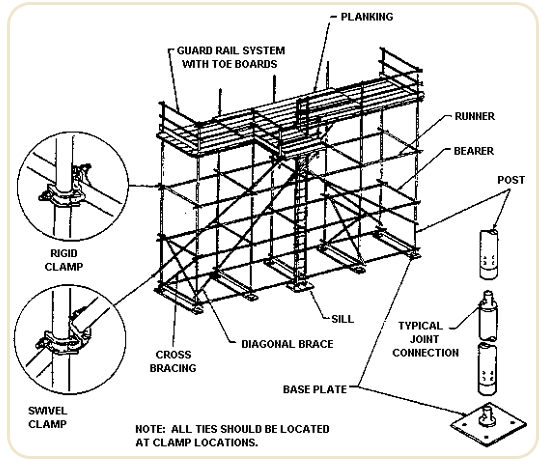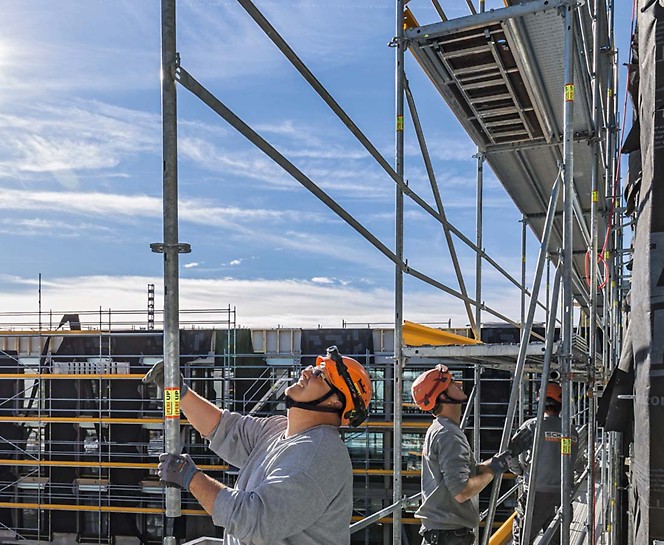Quality Scaffolding Surrey for Both Residential and Commercial Projects
Wiki Article
Discovering the Numerous Kinds Of Scaffolding Made Use Of in Building Projects
The building market relies greatly on various kinds of scaffolding to fulfill certain project needs, each offering distinct advantages and applications. Typical framework scaffolding gives a durable structure for general jobs, while suspended scaffolding is necessary for work on skyscraper structures.
Conventional Structure Scaffolding
Typical frame scaffolding is one of the most extensively utilized methods in the construction market as a result of its robustness and flexibility. This system contains vertical and horizontal frames that are assembled to produce a steady system for employees and materials. The major elements include vertical posts, horizontal ledgers, and angled dental braces, which together provide a strong framework that can support significant tons.Among the crucial advantages of traditional framework scaffolding is its adaptability to numerous building and construction jobs, varying from property buildings to huge industrial frameworks. The modular style enables very easy assembly and disassembly, making it efficient for both temporary and long-lasting projects. Furthermore, the system can be tailored in height and size, accommodating various building layouts and site conditions.
Safety and security is critical in scaffolding applications, and traditional framework systems are equipped with guardrails and toe boards to stop drops and make certain worker security. Routine examinations and adherence to safety laws are essential in preserving the stability of the scaffold (Scaffolding). On the whole, standard frame scaffolding remains an essential choice in the building sector, giving a reputable system for labor and boosting overall job effectiveness

Suspended Scaffolding
Suspended scaffolding offers a special remedy for building projects that call for accessibility to elevated surfaces, specifically in scenarios where typical structure scaffolding may be impractical. This kind of scaffolding is typically suspended from the roof covering or upper levels of a framework, using a system of systems, ropes, and pulleys to create a working space that can be adjusted to different heights.Among the main advantages of put on hold scaffolding is its flexibility. It can be easily repositioned or decreased to fit adjustments in building requirements, making it perfect for jobs such as window installment, frontage job, and maintenance on skyscrapers. Furthermore, the very little impact of suspended scaffolding permits far better use of ground room in urban atmospheres, where area is commonly limited.
Safety and security is a critical consideration in the use of put on hold scaffolding. On the whole, suspended scaffolding supplies a effective and effective remedy for accessing hard-to-reach locations in different building situations, enhancing both productivity and safety on site.
System Scaffolding
System scaffolding, often related to as a contemporary option in the scaffolding market, includes pre-engineered components that can be rapidly put together and adapted for numerous building and construction projects. Scaffolding. This kind of scaffolding is identified by its modular layout, which allows for convenience and effectiveness on work websites, fitting different heights and architectural demandsCommonly made from high-strength steel or light weight aluminum, system scaffolding uses boosted resilience and stability. The parts include vertical messages, horizontal journals, and diagonal braces, which adjoin firmly, making sure a robust structure. The design Scaffolding Guildford often integrates standardized fittings, streamlining setting up and disassembly processes, therefore reducing labor time and expenses.

Rolling Scaffolding
Rolling scaffolding is a flexible option to traditional fixed scaffolding, developed for wheelchair and simplicity of usage on building and construction websites. This kind of scaffolding is composed of a platform supported by frames with wheels, allowing workers to easily transfer it as required. The flexibility function dramatically boosts productivity, as it reduces downtime connected with disassembling and putting together taken care of scaffolding.Commonly created from lightweight materials such as light weight aluminum or steel, rolling scaffolding supplies a durable yet mobile solution for tasks calling for frequent repositioning - Scaffolding. It is specifically beneficial in jobs such as painting, drywall installation, and electric work, where access to numerous heights and areas is necessary
Safety is critical in rolling scaffolding design, with attributes such as locking wheels to stop unexpected motion when in operation, and guardrails to protect employees from falls. Furthermore, numerous versions are adjustable in elevation, fitting different job needs.
Cantilever Scaffolding

The layout of cantilever scaffolding normally entails making use of arms or braces secured to a building or structure, allowing the platform to extend outward securely. Safety and security is extremely important; hence, these scaffolds have to be crafted to hold up against various tons and environmental problems. Routine evaluation and maintenance are necessary to guarantee structural honesty and employee safety and security.
Cantilever scaffolding is preferred for its adaptability and effective usage of room, making it a preferred option in urban environments where room restraints are usual. Additionally, it assists in simpler accessibility to high altitudes, inevitably contributing to the overall performance of building projects. As with all scaffolding kinds, proper training and adherence to safety and security requirements are important for employees using cantilever scaffolding.
Verdict
In verdict, the diverse sorts of scaffolding utilized in building and construction jobs each serve distinct objectives customized to specific site requirements. Typical structure scaffolding offers security, while suspended scaffolding supplies flexibility for raised tasks. System scaffolding facilitates fast assembly, and rolling scaffolding improves flexibility for varying workplace. Cantilever scaffolding properly addresses challenges in city settings. Comprehending these scaffolding types is necessary for optimizing security and efficiency in building and construction, inevitably contributing to the effective conclusion of tasks.Traditional framework scaffolding gives a sturdy foundation for general tasks, while put on hold scaffolding is important for work on high-rise structures.Rolling scaffolding is a versatile alternative to conventional fixed scaffolding, developed for wheelchair and simplicity of usage on construction sites. As with all scaffolding types, correct training and adherence to safety and security criteria are vital for employees using cantilever scaffolding.
Conventional frame scaffolding provides stability, while put on hold scaffolding supplies convenience for raised jobs. System scaffolding facilitates quick setting up, and rolling scaffolding boosts wheelchair for varying job settings.
Report this wiki page